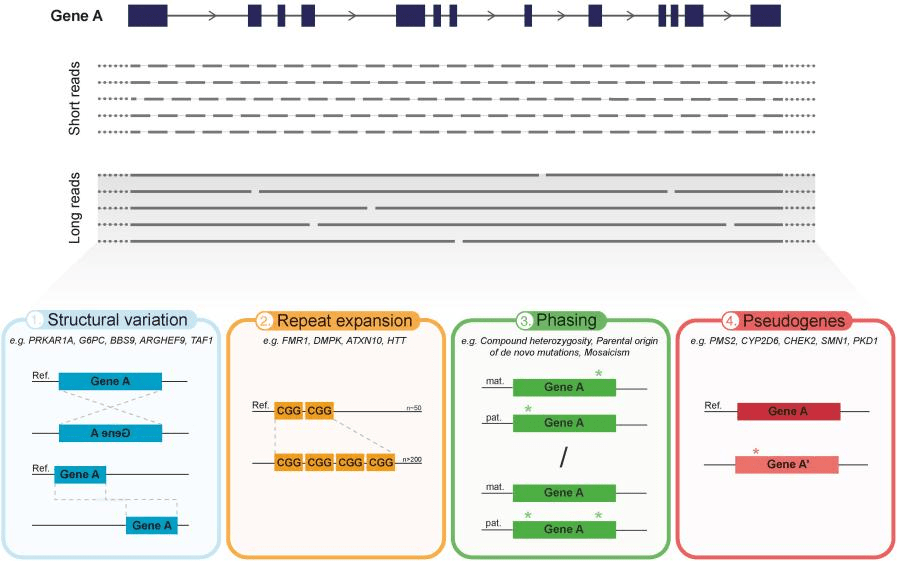We use cookies to understand how you use our site and to improve the overall user experience. This includes personalizing content and advertising. Read our Privacy Policy


We are dedicated to providing outstanding customer service and being reachable at all times.
Human Genomics with Long-Read Sequencing
CD Genomics is a leading custom service provider in the field of long-read sequencing. Our goal is to help clients accelerate their research and support their careers by using advanced third-generation sequencing platforms. By developing innovative, tailored, and cost-effective strategies, we can greatly accelerate the success of their projects.

The widespread use of next-generation sequencing (NGS) technology has revolutionized the field of human genetics. Within a decade, the massively parallel sequencing led to a dramatic increase in the understanding of genetic variation and allowed fast and accurate diagnostics of clinically cell (such as germline and somatic cells) mutations. However, traditional sequencing technologies (short-read sequencing), including Sanger sequencing and NGS technologies, can only provide short-read DNA fragments in the range of 50-1000 bases. The short-read sequencing approaches pose a series of limitations, including sequencing repetitive elements, identification of structural variants, and performing variant phasing (haplotyping). In addition, PCR amplification of sequencing templates not only introduces artifacts but also precludes the detection of natural base modifications. The emerging third-generation sequencing technologies (TGS), also known as long-read sequencing (LRS), can routinely generate reads longer than 10 kb and overcome some of the above-mentioned drawbacks.
Major Advantages of Current LRS Methods in Human Genetics
Compared to conventional short-read sequencing, the significant advantage of LRS approaches is the increase in reading length. Since LRS has a single read sequencing capacity averaging over 10 kb, fewer reads are needed to cover the same genes, reducing alignment as well as mapping errors. LRS has many other advantages, which can greatly impact human genetics, including,
-Improved identification of structural variation (SV), such as large insertions, deletions, and translocations.
-Capable of sequencing extremely GC-rich regions and long tandem repeat expansions.
-Enhanced assignment of genetic variants to the homologous chromosomes to facilitate the detection of inheritance patterns, allele-specific expression, disease risk haplotypes, and so on.
-Improved identification of clinically related genes from pseudogenes.
-Improved understanding of human genetic diversity and the mutational processes that shape the human genome.
 Fig2. Overview of the main advantages of current long-read sequencing (LRS) approaches in medical genetics. (Mantere, T., et al., 2019)
Fig2. Overview of the main advantages of current long-read sequencing (LRS) approaches in medical genetics. (Mantere, T., et al., 2019)
Our Long-Read Human Genome Sequencing
With recent developments in throughput and accuracy, long-read technologies have emerged as powerful tools in human genomics, such as resolving some of the most challenging regions of the human genome, detecting previously unavailable structural variants, and generating the first telomere-to-telomere assemblies of entire chromosomes. As one of the first commercial companies in the world to adopt long-read technology, we are proud to offer two major long-read technologies for human genomics research, namely PacBio SMRT sequencing and ONT Nanopore sequencing. Although they are competitive, some of the best results can be obtained when the sequencing platforms complement each other. Notably, our services are highly customized and flexible, and we will provide the best long-read sequencing services to meet your research goals.
Specific Service Offering
- Human Whole Genome Sequencing
- Human Long Amplicon Sequencing
- Human Mitochondrial DNA Sequencing
- Human Genome Structural Variation Detection
- Human Leukocyte Antigen (HLA) Typing
- Full-Length TCR/BCR Repertoire Profiling
Based on years of experience in the genomic field and advanced long-read sequencing technologies, CD Genomics is dedicated to helping scientists reveal the full spectrum of human genetic variation, address some of the missing heritability, and lead to the discovery of new disease mechanisms. If the service you are interested in is not listed above, please contact us and we will be happy to assist you.
References
- Logsdon, G. A., et al. (2020). "Long-read human genome sequencing and its applications." Nature Reviews Genetics, 21(10), 597-614.
- Mantere, T., et al. (2019). "Long-read sequencing emerging in medical genetics." Frontiers in genetics, 10, 426.
- Kraft, F., & Kurth, I. (2019). "Long-read sequencing in human genetics." Medizinische genetik, 31(2), 198-204.
For research purposes only, not intended for personal diagnosis, clinical testing, or health assessment